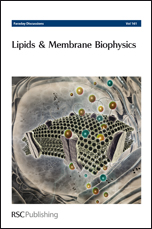Tuning the aggregation behaviour of single-chain bolaphospholipids in aqueous suspension: from nanoparticles to nanofibres to lamellar phases†
Abstract
The aggregation behaviour in aqueous suspensions of symmetrical bipolar phospholipids (bolalipids) composed of one long alkyl chain and two polar headgroups were studied as a function of their chemical structure, i.e. the length of their chain, the modification of the chain by introduction of hetero-atoms, triple bonds, or phenyl rings, and the size of the headgroups. Three types of aggregate structures are formed by these bolalipids, namely helical nanofibres, micelle-like aggregates and lamellar sheets. The type of aggregate formed depends not only on the chemical structure, particularly the ratio of the cross-sectional area of the headgroup and the chain, but also on the presence of attractive interactions via hydrogen bonds or repulsive electrostatic interactions between the headgroups.
- This article is part of the themed collection: Lipids & Membrane Biophysics

 Please wait while we load your content...
Please wait while we load your content...